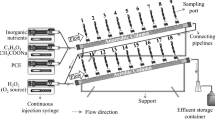Abstract
Historic spillages of chlorinated hydrocarbons at a vinyl chloride plant in the Rotterdam–Botlek area in The Netherlands has lead to deep-seated pollution of the underlying aquifer. The principal pollutant is 1,2-dichloroethane (1,2-DCA). As a temporary measure, the contamination is being contained using a pump and treat system. In the long term, in-situ bioremediation has been proposed using a biologically active zone where pollutants would be dechlorinated by microorganisms that simultaneously degrade other carbon sources. In order to investigate the suitability of this new technology, a programme of laboratory tests was carried out. The laboratory programme involved a series of anaerobic soil column tests, where the selection and delivery of different carbon substrates that stimulated 1,2-DCA dechlorination were investigated. The soil columns were prepared using soil and groundwater samples from boreholes. Groundwater was flushed through the columns under anaerobic conditions. A comparison was made between the transformation of 1,2-DCA without a carbon substrate and in the presence of sugars (molasses) and alcohol (methanol) respectively. In addition, different modes of delivery were investigated. In the case of molasses, the material was injected into the column as a plug to simulate grout injection in the field, whereas methanol was delivered as a constant flow dissolved in the influent. Both carbon substrates resulted in the biotransformation of 1,2-DCA. However, fermentation of molasses produced secondary effects that led to a drop in pH and an excessive production of carbon dioxide, which temporarily blocked the flow of groundwater.
Similar content being viewed by others
References
Adriaens, P. and Vogel, T. M. (1995) Biological treatment of chlorinated organics. Microbial Transformation and Degradation of Toxic Organic Chemicals, Young, L.Y. and Cerniglia, C.E. (eds), Wiley-Liss, New York, p. 654.
Bosma, T. N. P., Aalst-van Leeuwen, M. A., Gerritse, J. and van Heiningen, E. (1998) Intrinsic dechlorination of 1,2-dichloroethane at an industrial site. Proc. 1st Int. Conf. Remediation of chlorinated and recalcitrant compounds, Monterey, California.
Bouwer, E. J. (1994) Bioremediation of chlorinated solvents using alternate electron acceptors. Handbook of Bioremediation, Lewis Publishers, pp. 149-175.
Brady, N. C. and Weil, R. R. (1999) The Nature and Properties of Soils, Prentice Hall.
Chapelle, F. H. (1993) Groundwater Microbiology and Geochemistry, John Wiley and Sons.
Egli, C., Scholtz, R., Cook, A. and Leisinger, T. (1987) Anaerobic dechlorination of tetrachloromethane and 1,2-dichloroethane to degradable products by pure cultures of desulfobacterium sp. and methanobacterium sp. FEMS Microbiol Lett. 43, 257-261.
Freitas dos Santos, L. M. and Livingston, A. G. (1994) Extraction and biodegradation of a toxic volatile organic compound (1,2-dichloroethane) from waste-water in a membrane bioreactor. Appl. Microbiol. Biotechnol., 42, 421-431.
Gerritse, J. (1993) Growth of bacteria at low oxygen concentrations. PhD Thesis of the University of Groningen.
Gerritse, J., Borger, A., van Heiningen, E., Rijnaarts, H. M., Bosma, T. N. P., Taat, J., van Winden, B., Dijk, J. and de Bont, J. A. M. (1999) Assessment and monitoring of 1,2-dichloroethane dechlorination. Battelle Bioremediation Conference, San Diego, April, 1999.
Holliger, C., Schraa, G., Stams, A. J. M. and Zehnder, A. J. B. (1990) Reductive dechlorination of 1,2-dichloroethane and chloroethane by cell suspensions of methanogenic bacteria. Biodegradation, 1(4), 253–261.
Madigan, M. T., Martinko, J. M. and Parker, J. (1997) Brock Biology of Microorganisms, Prentice Hall.
Singleton, P. (1999) Bacteria in Biology, Biotechnology and Medicine. John Wiley and Sons, Chapter 4.
Stucki, G. and Thüer, M. (1995) Experiences of a large-scale application of 1,2-dichloroethane degrading micro-organisms for groundwater treatment. Environ. Sci. Technol., 29(9), 2339–2345.
Suthersan, S. S. (1997) Remediation Engineering Design Concepts, CRC Press.
Author information
Authors and Affiliations
Rights and permissions
About this article
Cite this article
Dyer, M., van Heiningen, E. & Gerritse, J. In situ bioremediation of 1,2-dichloroethane under anaerobic conditions. Geotechnical and Geological Engineering 18, 313–334 (2000). https://doi.org/10.1023/A:1016699701105
Issue Date:
DOI: https://doi.org/10.1023/A:1016699701105




